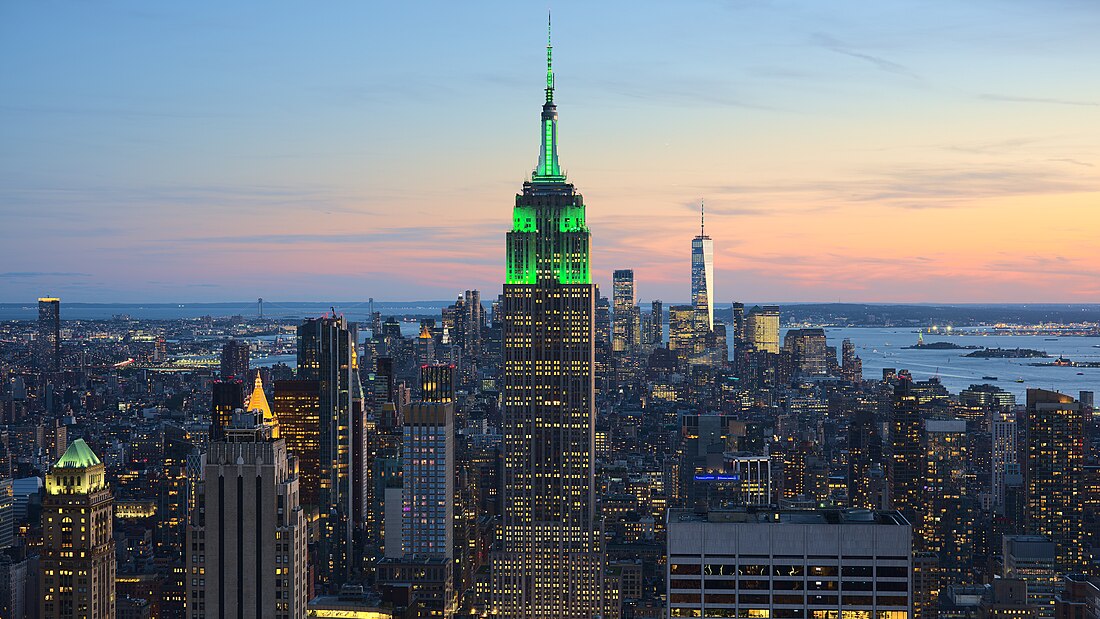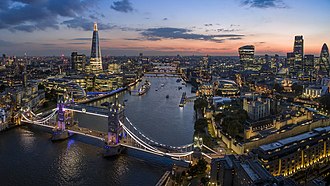Global city
City important to the world economy From Wikipedia, the free encyclopedia
A global city[a] is a city that serves as a primary node in the global economic network. The concept originates from geography and urban studies, based on the thesis that globalization has created a hierarchy of strategic geographic locations with varying degrees of influence over finance, trade, and culture worldwide.[1][2][3] The global city represents the most complex and significant hub within the international system, characterized by links binding it to other cities that have direct, tangible effects on global socioeconomic affairs.[4]
New York City (top) and London (bottom) are the only two cities ranked in the Alpha ++ category by the Globalization and World Cities Research Network. Both cities are considered leading financial, commercial and cultural centers.
The criteria of a global city vary depending on the source.[5] Common features include a high degree of urban development, a large population, the presence of major multinational companies, a significant and globalized financial sector, a well-developed and internationally linked transportation infrastructure, local or national economic dominance, high quality educational and research institutions, and a globally influential output of ideas, innovations, or cultural products. Quintessential examples, based on most indices and research, include New York City, London, Paris, and Tokyo.
Origin and terminology
The term 'global city' was popularized by sociologist Saskia Sassen in her 1991 book, The Global City: New York, London, Tokyo.[6] Before then, other terms were used for urban centers with roughly the same features. The term 'world city', meaning a city heavily involved in global trade, appeared in a May 1886 description of Liverpool, by The Illustrated London News;[7] British sociologist and geographer Patrick Geddes used the term in 1915.[8] The term 'megacity' entered common use in the late 19th or early 20th century, the earliest known example being a publication by the University of Texas in 1904.[9] In the 21st century, the terms are usually focused on a city's financial power and high technology infrastructure.[10][11]
Criteria
Summarize
Perspective

Competing groups have devised competing means to classify and rank world cities and to distinguish them from other cities.[8] Although there is a consensus on the leading world cities,[13] the chosen criteria affect which other cities are included.[8] Selection criteria may be based on a yardstick value (e.g., if the producer-service sector is the largest sector then city X is a world city)[8] or on an imminent determination (if the producer-service sector of city X is greater than the combined producer-service sectors of N other cities then city X is a world city.)[8] Although criteria are variable and fluid, typical characteristics of world cities include:[14]
- The most prominent criterion has been providing a variety of international financial services,[15] notably in finance, insurance, real estate, banking, accountancy, and marketing; and their amalgamation of financial headquarters, a stock exchange, and other major financial institutions,
- Headquarters of numerous multinational corporations,
- Domination of the trade and economy of a large surrounding area,
- Major manufacturing centers with port and container facilities,
- Considerable decision-making power daily and at a global level,
- Centers of new ideas and innovation in business, economics, and culture,
- Centers of digital and other media and communications for global networks,
- The dominance of the national region with great international significance,
- The high percentage of residents employed in the services sector and information sector,
- High-quality educational institutions, including renowned universities and research facilities; and attracting international student attendance,[16]
- Multi-functional infrastructure offering some of the best legal, medical, and entertainment facilities in the country,
- High diversity in language, culture, religion, and ideologies.
General rankings
Summarize
Perspective
Global city rankings are numerous.[17] New York City, London, Tokyo, and Paris are the most commonly mentioned.[18][19]
GaWC World Cities
The Globalization and World Cities Research Network (GaWC) is a British think tank that studies the relationships between world cities in the context of globalization. It is based in the geography department of Loughborough University in Leicestershire, United Kingdom. GaWC was founded by Peter J. Taylor in 1998.[20] Together with Jon Beaverstock and Richard G. Smith, they create the GaWC's biennial categorization of world cities into "Alpha", "Beta" and "Gamma" tiers. The three tiers are further divided into subgroupings using plus and minus signs. The categorization is based upon the author's views of "international connectedness", primarily shown through a regions advanced services firms, such as in accountancy, finance and law).[21] Primarily concerned with what it calls the "advanced producer services" of accountancy, advertising, banking/finance, and law, the cities in the top two classifications in the 2024 edition are:[22]
Alpha ++
Alpha +
Global Cities Index (Kearney)
In 2008, the American journal Foreign Policy, working with the consulting firm A.T. Kearney and the Chicago Council on Global Affairs, published a ranking of global cities based on consultation with Saskia Sassen, Witold Rybczynski, and others.[23][24] The ranking is based on 27 metrics across five dimensions: business activity, human capital, information exchange, cultural experience, and political engagement.[25] The top ranked cities in 2024 are:[26]
Global Cities Index (Oxford Economics)
Advisory firm Oxford Economics released its Global Cities Index in 2024, ranking the world's largest 1,000 cities based on 27 indicators across five categories (economics, human capital, quality of life, environment, and governance) with more weight on economic factors. The top ranked cities in 2024 are:[27]
Global Cities Initiative
A study by Brookings Institution conducted in 2016 introduced its own typology, sorting global cities into seven categories: Global Giants, Asian Anchors, Emerging Gateways, Factory China, Knowledge Capitals, American Middleweights, and International Middleweights.[28]
The Global Giants classification includes wealthy, extremely large metropolitan areas that are the largest cities in developed nations. They are hubs for financial markets and major corporations, and serve as key nodes in global flows of capital and of talent.
The World's Most Talked About Cities
A study by ING Media, a London-based built environment communications firm, has ranked 250 global cities by total online mentions across social media and online news for 2019. It found that a fifth of digital mentions were for Tokyo, New York City, London, and Paris, identifying these as the world's super brands.[29][30] The Top 10 in the 2019 edition were:[31]
Global Power City Index
The Tokyo-based Institute for Urban Strategies at The Mori Memorial Foundation, issued a study of global cities in 2008. They are ranked in six categories: economy, research and development, cultural interaction, livability, environment, and accessibility, with 70 individual indicators among them. The top ten world cities are also ranked by subjective categories, including manager, researcher, artist, visitor and resident.[32][33] The top 10 cities in 2023 are:[32]
World's Best Cities ranking
Consultancy firm Resonance publishes the World's Best Cities ranking. They are ranked in three categories: livability, lovability and prosperity, each of them using different factors. The top 10 cities in 2024 are:[34]
Financial rankings
Global Financial Centres Index
Strength as a financial center has become one of the pre-eminent indicators of a global city's ranking. As of 2024,[35] the cities representing the top ten financial centers according to the Global Financial Centres Index by the think tank China Development Institute and analytics firm Z/Yen are:[36]
The Wealth Report
Estate agent Knight Frank LLP and the Citi Private Bank publish The Wealth Report, which includes a "Global Cities Survey", evaluating the most important cities to high-net-worth individuals (HNWIs, having over $25 million of investable assets each). Criteria are economic activity, political power, knowledge and influence, and quality of life.[37][38] The most important cities to UHNWIs in 2022 are:[39]
See also
Notes
References
External links
Wikiwand - on
Seamless Wikipedia browsing. On steroids.


